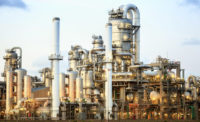 The U.S. Chemical Safety Board (USB) was briefed last week on a report resulting from the fatal 2008 explosion at the Bayer CropScience manufacturing complex near Charleston, West Virginia.
The U.S. Chemical Safety Board (USB) was briefed last week on a report resulting from the fatal 2008 explosion at the Bayer CropScience manufacturing complex near Charleston, West Virginia.
USB Chairperson Rafael Moure Eraso said the board will review the report from the National Academy of Sciences (NAS) in detail over the next few weeks.
The study is the result of a September 2010 contract with the NAS on the feasibility of reducing or eliminating the inventory of highly toxic methyl isocyanate stored at the Bayer facility.
The $575,000 study was mandated by Congress late in 2009 as part of the fiscal year 2010 CSB operating budget and resulted from the Bayer facility explosion that killed two plant employees and endangered a nearby aboveground storage tank containing approximately 13,000 pounds of methyl isocyanate or MIC. The CSB and a Congressional committee investigated the accident and its aftermath
After sustained public attention to the dangers of MIC after the 2008 accident, in August 2009 Bayer announced measures to reduce the hazards of MIC, including an inventory reduction of approximately 80%. In August 2010, the U.S. Environmental Protection Agency (EPA) announced an agreement with Bayer to phase out production of one of two remaining MIC-derived pesticides made at the plant (aldicarb) due to toxicity concerns. That action followed a December 2009 EPA ban on carbofuran, another MIC derivative made in Institute.
The CSB’s investigation of the root causes of the August 2008 explosion at the Bayer plant was released at a public meeting in Institute, West Virginia on January 20, 2011. The final report, safety recommendations and safety video are available at www.csb.gov.
The CSB is an independent federal agency charged with investigating serious chemical accidents. The agency's board members are appointed by the president and confirmed by the Senate. CSB investigations look into all aspects of chemical accidents, including physical causes such as equipment.



